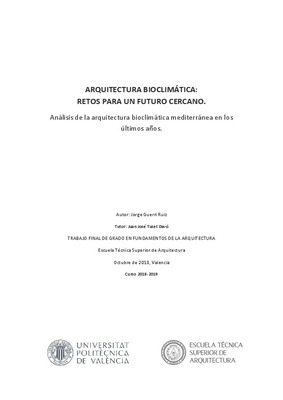JavaScript is disabled for your browser. Some features of this site may not work without it.
Buscar en RiuNet
Listar
Mi cuenta
Estadísticas
Ayuda RiuNet
Admin. UPV
Arquitectura bioclimática. Retos para un futuro cercano
Mostrar el registro sencillo del ítem
Ficheros en el ítem
| dc.contributor.advisor | Tuset Davó, Juan José
|
es_ES |
| dc.contributor.author | Guerri Ruiz, Jorge
|
es_ES |
| dc.date.accessioned | 2020-01-28T09:28:14Z | |
| dc.date.available | 2020-01-28T09:28:14Z | |
| dc.date.created | 2018-10-25 | |
| dc.date.issued | 2020-01-28 | es_ES |
| dc.identifier.uri | http://hdl.handle.net/10251/135813 | |
| dc.description.abstract | [ES] Con el título genérico Arquitectura bioclimática. Retos para un futuro cercano se propone una investigación sobre el alcance que tienen los fundamentos del diseño bioclimático en la arquitectura contemporánea. El trabajo aborda de manera crítica la obra de algunos arquitectos de los últimos 25 años. El objetivo es extraer unas pautas de diseño posibles para la arquitectura que está por venir. La arquitectura Bioclimática es beneficiosa en muchos aspectos. No solo permite ahorrar grandes cantidades de energía, lo que supone un ahorro económico a la vez que beneficia al planeta. También mejora la calidad de vida de la gente que habita en este tipo de viviendas. Se trata pues de una arquitectura que nos aporta grandes beneficios. Además es posible de lograr mediante sencillos cambios y con la toma de las correctas decisiones durante el proceso de diseño del edificio. Por esta razón es importante la formación del arquitecto en este campo, que (junto a la rama de sostenibilidad y autosuficiencia) forma parte sin duda del futuro de la arquitectura. El clima es un factor fundamental, y cada situación debe estudiarse a fondo para lograr un correcto uso de las estrategias bioclimáticas. Por ello es necesario indagar en este aspecto también. Por limitar un poco este amplio ámbito, se opta por centrarse en el clima mediterráneo, que es donde se encuentra la gran parte de España, y que además se reparte por más zonas del planeta. Esto supone una diversidad cultural, lo que puede significar distintas maneras de enfrentarse al problema. A lo largo del trabajo se investigarán las diferentes estrategias bioclimáticas según las necesidades del edificio. Se repasarán los distintos tipos climas, incidiendo en el mediterráneo. Y por último se analizarán cuatro viviendas contemporáneas pertenecientes a éste clima, y repartidas en distintas áreas de la Tierra, con el fin de saber en qué situación se encuentra la arquitectura bioclimática, hacia dónde se dirige, y si esta dirección es la correcta. | es_ES |
| dc.description.abstract | [EN] With the generic title "Bioclimatic architecture. Challenges for a near future" it is proposed an investigation in what scope do the basics in bioclimatic design in contemporary architecture have. The work approaches in a critic way the some architect's buildings from up to a max of the past 25 years. The goal is to extract the new ways for the architecture that is about to come. Bioclimatic architecture is beneficial in so many ways. Not only does it allow lots of savings in energy, which means an economic saving at the same time it benefits the planet. But it also betters the life quality for the people who habits in these kinds of buildings. It is so, a type of architecture that brings us huge benefits in every way. It¿s also easy to achieve thru small changes and by making the right decisions during the design process. This is why it is important to train the architect in this field, since it is without doubt part of the future of architecture, together with sustainability and self efficiency. Climatology is a fundamental factor, and therefore each emplacement must be studied thoroughly to achieve a correct use of the bioclimatic strategies. This is the reason why it seems necessary to inquire in this aspect. To reduce this open field, it is decided to stick to Mediterranean climate, since this is where Spain is located, and it is also spread into different parts of the world. This means a cultural diversity, which can lead into different ways to deal with the same problem. Throughout the work, the different bioclimatic strategies will be investigated, depending on what the building needs. Different types of climate will be reviewed, centering the attention in the Mediterranean. And lastly, four contemporary Mediterranean buildings from different cultures will be analyzed to find out in which situation does the bioclimatic architecture find itself right now, where is it headed to, and if the direction it has is the correct. | es_ES |
| dc.language | Español | es_ES |
| dc.publisher | Universitat Politècnica de València | es_ES |
| dc.rights | Reserva de todos los derechos | es_ES |
| dc.subject | Sostenibilidad | es_ES |
| dc.subject | Eficiencia energética | es_ES |
| dc.subject | Sistemas pasivos | es_ES |
| dc.subject | Control climático | es_ES |
| dc.subject | Medio ambiente | es_ES |
| dc.subject | Sustainability | es_ES |
| dc.subject | Energy efficiency | es_ES |
| dc.subject | Passive systems | es_ES |
| dc.subject | Climate control | es_ES |
| dc.subject | Environment | es_ES |
| dc.subject.classification | PROYECTOS ARQUITECTONICOS | es_ES |
| dc.subject.other | Grado en Fundamentos de la Arquitectura-Grau en Fonaments de l'Arquitectura | es_ES |
| dc.title | Arquitectura bioclimática. Retos para un futuro cercano | es_ES |
| dc.type | Proyecto/Trabajo fin de carrera/grado | es_ES |
| dc.rights.accessRights | Abierto | es_ES |
| dc.description.bibliographicCitation | Guerri Ruiz, J. (2018). Arquitectura bioclimática. Retos para un futuro cercano. http://hdl.handle.net/10251/135813 | es_ES |
| dc.description.accrualMethod | TFGM | es_ES |
| dc.relation.pasarela | TFGM\77908 | es_ES |
Este ítem aparece en la(s) siguiente(s) colección(ones)
-
ETSA - Trabajos académicos [4493]
Escuela Técnica Superior de Arquitectura






